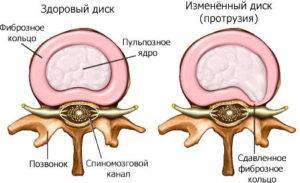The spine is a complex system of the body, which consists of vertebrae between which the intervertebral discs, which is a cartilage. Each disc consists of two shells – durable exterior and soft interior. The internal sheath can be compared with the shock absorber, which is particularly important when the movements of a person.
When a particular disease of the inner soft part of the disc can bulge, or even a little torn outer, dense layer, which often is called a herniated disc.
While trapped outside the inner soft part may begin to compress or irritate the nerve roots, which leads to severe pain. In more serious cases the nerve roots can be quite badly damaged.
Reasons
The strain of intervertebral disc pathology, which often occurs after a trauma, the trauma can be very different – falling from a height, car accident, falling from his own height and more. And in some cases the trauma may not have a direct effect on the spine.
Most often indirect injury leads to anguish, when there are predisposing factors such as degenerative changes of the vertebrae or other diseases of the osteochondrosis, scoliosis, and others. In addition, the tear can happen with compression fracture or even a dislocation and subluxation of the vertebrae, which frequently occurs in the cervical spine.

The clinical picture
The main symptom, which first drew the attention that the pain can be of different nature and intensity. Most often the pain a person experiences at the level of the waist, as according to statistics, the strain of the intervertebral disc mainly happens here.
The second manifestation is a tingling in both or one leg as well as muscle weakness and numbness in the extremities. In severe cases, may develop paresis and paralysis. The symptoms will mainly depend on at what level the damage occurred and what the roots are corrupted, and must take into account the extent of the gap.
Diagnosis
At diagnosis an important role is played by such factors as the mechanism of injury, and orthopedic and neurological status of the victim. The x-rays it is easy to see reducing the height of the damaged disc, displacement of the vertebral bodies, and a place of anguish. For a more detailed diagnosis, and to understand, what is the length of the tear and whether there is loss of the nucleus pulposus, can be applied methods such as CT or MRI.
Treatment
Treatment is entirely dependent on how clear neurological manifestations and the severity of already existing degenerative changes. If the clinic is dominated by low-grade pain, and the anguish of the disc diagnosed without spinal cord compression, in this case, the use of orthopedic corset.

When the diagnosis has been a slight radicular syndrome, we always perform traction by using loop Gleason. The duration of treatment is 1 to 2 weeks and after that superimposed orthopedic corset.
In case of pronounced pain syndrome use painkillers and medicines that help to relieve swelling in the area of damage, and medicines that help to normalize blood circulation, which is important for quick, non-surgical healing.
If the symptoms are very strong, and neurological manifestations of reach of paresis or paralysis, as well as when existing degenerative changes in the spine, surgical treatment.
Operative treatment is identical to treatment of degenerative disc disease and aimed at eliminating its compression, and to prevent further progression of degenerative changes. This files most often injured segment is completely removed, after which the vertebrae are strengthened by specially designed systems.




Thanx for the effort, keep up the good work Great work, I am going to start a small Blog Engine course work using your site I hope you enjoy blogging with the popular BlogEngine.Thethoughts you express are really awesome. Hope you will right some more posts.
I needed to thank you for this great read!! I absolutely loved every little bit of it. I have you saved as a favorite to check out new things you post…
I’ll immediately snatch your rss feed as I can not to find your email subscription hyperlink or e-newsletter service.
Do you’ve any? Please permit me understand so that I could subscribe.
Thanks.
Hi, I think your site might be having browser compatibility issues.
When I look at your blog site in Ie, it looks fine but when opening in Internet Explorer, it has some overlapping.
I just wanted to give you a quick heads up! Other then that, amazing blog!